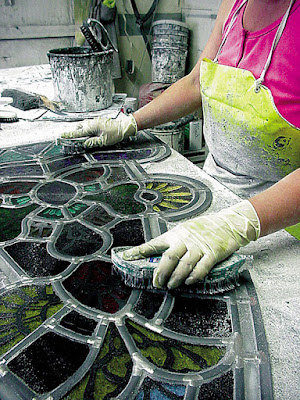A frequently asked question by novice glass workers is
whether to score at one side of the line or in the middle. This question revolves around the meaning of
the cartoon lines. What do the lines of
a cartoon represent?
Meaning of Cartoon
Lines
The lines on a cut line cartoon represent the space required
between pieces of glass. This will vary,
depending on the style in which you are working. In most glass working, a matrix of lead or
foil is used. The space required by
these materials needs to be represented in the cut line cartoon. You may have
other cartoons for other purposes – painting, came width, foil width, etc., but
the lines in the cut line cartoon are there to represent the space required
between pieces of glass.
 |
| An example of a cartoon for painting |
Lead Came
In general, a 1.2mm line is required for standard lead came.
This is close to the line made by a new bullet pointed felt tipped marker. If
you are working with high heart cames, you will need a 2.8mm wide line. Some
chisel point markers, if used on the sharp edge have this approximate width.
The glass is scored at the inside edge of the cartoon line. This can be done by scoring directly on top
of the cartoon, often with a light underneath.
You can make pattern pieces when the glass is too dense for enough light
to come through. If you must, you can
draw the score line on the glass. You can score around pattern pieces, but if
your scoring wheel goes over the pattern in any place, the scoring pressure
will not be delivered to the glass.
 |
| Example of came varieties |
Copper Foil
In copper foil, a much thinner line is used as the space
between pieces of glass needs only be approximately 0.4mm. This is
approximately the width of a sharpened pencil or ball point pen line.
The scoring is at the edge of the line as for lead
came. Also, you can score directly over
the cartoon, draw on the glass, or make pattern pieces as for lead came
projects.
Fusing Cartoons
When preparing a cartoon for fusing, the lines need to be as
fine as possible. The pieces of glass
require no space, as they will be butted against each other. However, unless cutting by computer
controlled instruments, the cutting cannot be completely accurate, so the same
size of line as for copper foil will do.
As you are going to try to butt the glass pieces together in
fusing projects, you score along the middle of the cartoon lines. As much as possible, cutting over the cartoon
will give the best result. Of course,
there are many times when the light is not good enough and pattern pieces will
be required.
Another approach is also possible. Having scored and broken
the first piece, you can place it on top of the glass to be cut for the
adjoining one. With a very fine felt tip
or fountain pen, trace the edge of the first piece. Score down the middle of that
line to create the best fitting second piece.
And so on through the whole project where the glass is not too dense to
use a light box.
Conclusion
The line widths in a cartoon are determined by the space
required between pieces by the assembly method.
The thicker the matrix material, the thicker the line and vice versa.

































